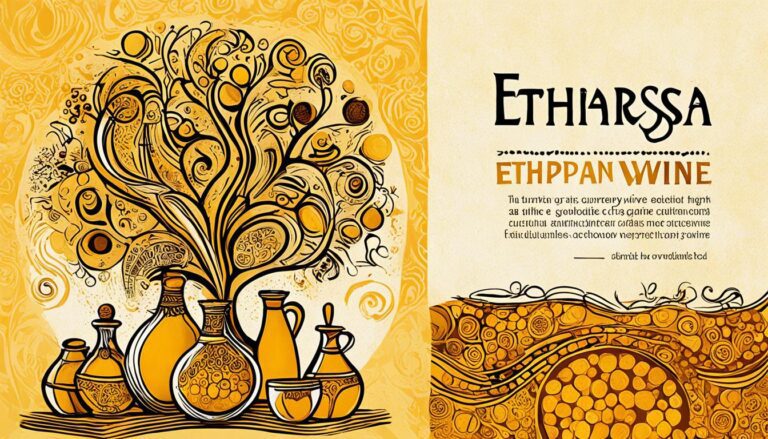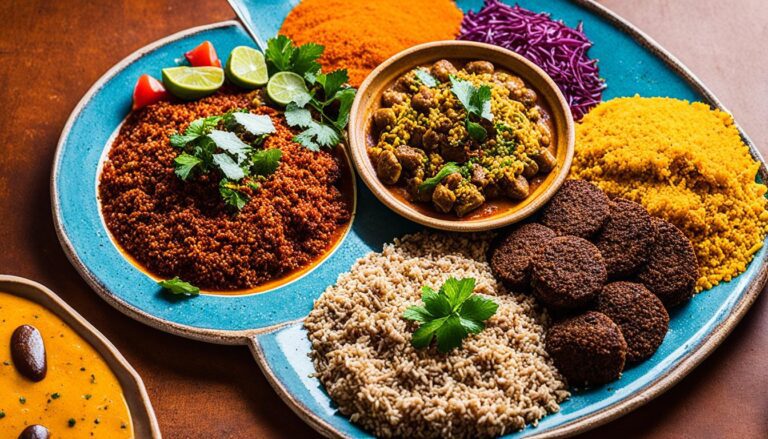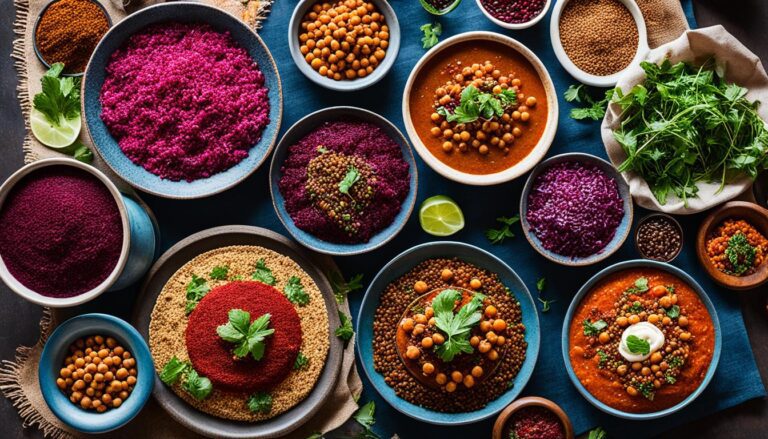Traditional Ethiopian Dishes
Traditional Ethiopian Dishes: A Culinary Exploration
Ethiopian cuisine is a delightful tapestry of flavors, colors, and textures that reflect the country’s rich history and diverse cultural influences. From hearty stews to spicy sautéed meats and vegetables, Ethiopia offers a unique culinary experience that is sure to tantalize the taste buds of food enthusiasts worldwide.
One of the most iconic Ethiopian dishes is Doro Wat, a spicy chicken stew that is often considered the national dish of Ethiopia. Made with tender chicken simmered in a blend of berbere spice, onions, garlic, and ginger, Doro Wat is typically served with injera, a sourdough flatbread that also doubles as a utensil for scooping up the flavorful stew.
Kitfo is another must-try Ethiopian delicacy, consisting of minced raw beef marinated in mitmita (a fiery chili powder blend) and niter kibbeh (spiced clarified butter). This dish is often served with ayib (a mild cottage cheese) and greens, providing a harmonious balance of flavors and textures.
For vegetarians and vegans, Ethiopian cuisine offers a plethora of options such as Misir Wat, a spicy red lentil stew, and Gomen, a dish made with collard greens, garlic, and ginger. These dishes are not only delicious but also showcase the use of bold spices and aromatic herbs that are characteristic of Ethiopian cooking.
No exploration of Ethiopian cuisine would be complete without mentioning Injera, the ubiquitous sourdough flatbread that serves as the foundation of most Ethiopian meals. Made from teff flour, injera has a spongy texture and a slightly tangy taste that pairs perfectly with the various curries, stews, and salads that adorn it.
In addition to these well-known dishes, Ethiopia boasts a wide array of regional specialties such as Tibs (sautéed meat dishes), Shiro (a flavorful chickpea stew), and Atkilt Wat (a hearty vegetable stew). Each region of Ethiopia brings its own unique twist to these dishes, showcasing the country’s culinary diversity and the importance of food in Ethiopian culture.
Traditional Ethiopian dishes offer a vibrant and flavorful journey for anyone willing to explore the rich tapestry of flavors that this East African country has to offer. Whether you are a meat lover, a vegetarian, or a vegan, Ethiopian cuisine has something special to delight your palate and leave you craving for more.
Origins and Influences of Ethiopian Cuisine
Ethiopian cuisine is a delightful fusion of flavorful spices, hearty stews, and unique cooking techniques that have been perfected over generations. The roots of Ethiopian cuisine can be traced back to ancient times, with influences from diverse cultures such as Indian, Arabic, Turkish, and Italian. This rich tapestry of influences has shaped the culinary landscape of Ethiopia, making it a truly unique and vibrant cuisine in the African continent.
One of the hallmarks of Ethiopian cuisine is the distinct use of spices and herbs that add depth and complexity to the dishes. Berbere, a fiery red pepper spice blend, is a cornerstone of Ethiopian cooking, used to season various meat and vegetable dishes. Another essential spice is mitmita, a hot chili powder that lends a fiery kick to many traditional Ethiopian recipes.
Injera, a spongy flatbread made from teff flour, is a staple in Ethiopian cuisine and is often used as a utensil to scoop up stews and salads. This gluten-free bread is a versatile component of Ethiopian meals and is central to the dining experience. Additionally, wat, a spicy stew made with onions, garlic, and various meats or legumes, is a ubiquitous dish in Ethiopian households and restaurants.
The influences of Ethiopian cuisine extend beyond its borders, with Ethiopian restaurants gaining popularity around the world. The communal style of eating, where dishes are shared among diners and enjoyed with injera, has made Ethiopian cuisine a favorite among food enthusiasts looking for a unique and interactive dining experience.
Ethiopian cuisine’s emphasis on fresh ingredients, bold flavors, and communal dining fosters a sense of togetherness and celebration. Whether you are savoring a hearty doro wat (spicy chicken stew) or sampling a variety of vegetarian and vegan dishes like misir wat (red lentil stew) and gomen (collard greens), Ethiopian cuisine offers a delightful culinary journey for all food lovers.
Vegan and Vegetarian Options in Ethiopian Food
Ethiopian cuisine is a treasure trove for vegans and vegetarians with its wide array of plant-based dishes that are not only flavorful but also culturally significant. Injera, a spongy flatbread made from teff flour, is a staple in Ethiopian cuisine and is naturally gluten-free, making it a popular choice among those with dietary restrictions. This versatile bread is typically used to scoop up various vegetable and lentil dishes, making it a perfect accompaniment for plant-based eaters.
One of the most famous Ethiopian vegan dishes is Misir Wot, a spicy red lentil stew that is simmered in a berbere spice blend. Berbere, a key ingredient in Ethiopian cooking, is a fiery mixture of spices that lends depth and heat to dishes. Another beloved vegan dish is Shiro, a smooth and hearty chickpea stew that is often served with injera. The use of flavorful spices like garlic, onion, and turmeric sets Ethiopian cuisine apart and creates rich and satisfying plant-based meals.
For those looking to explore a variety of vegan options, a traditional Ethiopian platter, known as Beyaynetu, offers a selection of vegetable and lentil dishes that showcase the diversity of flavors in Ethiopian cooking. This platter typically includes dishes such as Gomen (collard greens), Atakilt Wat (cabbage and carrots), and Fosolia (green beans and carrots), providing a well-rounded dining experience for vegans and vegetarians alike.
In addition to main dishes, Ethiopian cuisine also boasts an array of vegan-friendly side dishes and condiments. Azifa, a vibrant green lentil salad marinated in zesty vinaigrette, is a refreshing and tangy addition to any meal. Ayib, a soft and crumbly cheese similar to cottage cheese but dairy-free, offers a creamy contrast to the bold flavors of Ethiopian spices.
Ethiopian cuisine’s emphasis on fresh ingredients, aromatic spices, and diverse cooking techniques makes it a paradise for vegans and vegetarians seeking delicious and culturally rich dining experiences. Whether enjoying a communal meal at a traditional Ethiopian restaurant or exploring plant-based options at home, the vibrant flavors and textures of Ethiopian vegan and vegetarian dishes are sure to captivate the taste buds and leave a lasting impression.
Lesser-Known Ethiopian Dishes Worth Trying
When it comes to Ethiopian cuisine, most people are familiar with staples like injera, doro wat, and kitfo. However, Ethiopia’s culinary landscape offers a plethora of lesser-known dishes that are just as delicious and worth exploring. These hidden gems provide a unique taste of Ethiopian culture and traditions beyond the more commonly known fare.
One such dish is “Tibs Firfir,” a delightful combination of injera strips stir-fried with seasoned beef or lamb tibs. This dish offers a textural contrast between the soft injera and the savory tibs, elevated by aromatic Ethiopian spices. Tibs Firfir is a comforting and flavorful option for those looking to expand their Ethiopian palate.
For those seeking a dish with a bit of heat, “Dulet” is a must-try. This traditional Ethiopian dish consists of minced lamb or beef tripe, liver, and lean meat, sautéed with onions, garlic, and a blend of spices. Dulet is often enjoyed with injera and is prized for its robust flavors and spicy kick.
Ethiopia’s rich culinary heritage is also showcased in “Yebeg Alicha,” a mild and soothing dish perfect for those who prefer less spicy fare. Yebeg Alicha features tender pieces of lamb simmered in a fragrant broth of turmeric, ginger, garlic, and traditional Ethiopian spices. This dish exemplifies the diversity of flavors found in Ethiopian cuisine.
For seafood enthusiasts, “Asa Be Mitmita” is a hidden culinary gem that deserves recognition. This dish consists of spicy grilled fish seasoned with mitmita, a fiery Ethiopian spice blend. Asa Be Mitmita offers a mouthwatering experience that highlights Ethiopia’s lesser-known but equally delectable seafood offerings.
In addition to these dishes, exploring Ethiopian specialties like “Fesagniya” (Ethiopian-style lasagna), “Gomen Kitfo” (spiced minced collard greens), and “Ayib Be Gomen” (cottage cheese with collard greens) can provide a deeper understanding of the diverse flavors present in Ethiopian cuisine. These lesser-known dishes present an opportunity to delve into Ethiopia’s culinary secrets and savor a taste of tradition and innovation in each bite.
While Ethiopian cuisine is renowned for its iconic dishes, delving into the world of lesser-known Ethiopian delicacies can be a rewarding culinary adventure. From Tibs Firfir to Dulet, Yebeg Alicha, and Asa Be Mitmita, these dishes offer a glimpse into the depth and diversity of Ethiopian gastronomy, inviting food enthusiasts to broaden their horizons and experience the rich tapestry of flavors that this East African country has to offer.
Regional Variations in Ethiopian Gastronomy
When exploring Ethiopian cuisine, one cannot overlook the diverse regional variations that contribute to the country’s rich gastronomic tapestry. Ethiopia’s culinary landscape is a reflection of its varied geography, climate, and cultural influences, resulting in a wide array of flavors and cooking techniques that differ from one region to another.
One of the most renowned regional cuisines in Ethiopia is the cuisine of Tigray. Located in the northern part of the country, Tigrayan dishes are known for their unique spice blends and the predominant use of clarified butter, locally known as niter kibbeh. Signature dishes from this region include tsebhi dorho, a flavorful chicken stew, and tihlo, a dish made with roasted barley and chickpea flour.
On the other hand, the Oromia region boasts a cuisine characterized by spicy meat dishes and a wide variety of gluten-free bread made from teff flour. Dishes like dulet, a spicy minced meat dish, and kitfo, seasoned raw meat, are popular in this region. In contrast, the cuisine of the Southern Nations, Nationalities, and Peoples’ Region features an abundance of fresh vegetables, fruits, and grains. Injera, a sourdough flatbread, remains a staple in Ethiopian cuisine across different regions.
Heading to the eastern part of Ethiopia, Somali-influenced dishes such as injera with berbere-coated goat meat are prevalent. The Afar region, known for its hot and arid climate, offers unique dishes like fata, a hearty soup made with bread, butter, and spices. Meanwhile, in the Amhara region, you can find traditional dishes like doro wat, a spicy chicken stew, and shiro, a flavorful chickpea paste.
The regional variations in Ethiopian gastronomy highlight the country’s diverse culinary traditions and the importance of local ingredients and cooking methods in shaping each region’s distinctive flavors. Whether you find yourself in the highlands of Tigray or the lowlands of the Somali region, exploring Ethiopia’s regional cuisines is a delightful journey through a tapestry of flavors, spices, and culinary heritage.
Conclusion
In exploring the traditional Ethiopian dishes that have captivated food enthusiasts worldwide, it becomes evident that Ethiopian cuisine offers a rich tapestry of flavors, textures, and cultural significance. The origins and influences of Ethiopian cuisine date back centuries, shaped by a diverse range of historical, geographical, and cultural factors. This culinary legacy is characterized by a unique blend of indigenous ingredients, cooking techniques, and traditions that have stood the test of time.
One of the remarkable aspects of Ethiopian cuisine is its embrace of vegan and vegetarian options, making it a haven for plant-based eaters. From hearty lentil stews to vibrant vegetable dishes, Ethiopian food provides a plethora of flavorful choices that cater to diverse dietary preferences. The use of injera, a sourdough flatbread made from teff flour, further enhances the experience by serving as a versatile and nutritious base for various dishes.
While some Ethiopian dishes like injera, doro wat, and kitfo have gained international recognition, there is a hidden culinary world waiting to be discovered. Lesser-known gems such as tibs, shiro, and atkilt wat offer an exciting twist to the Ethiopian dining experience, showcasing the depth and diversity of the country’s gastronomic heritage. These dishes provide a gateway to explore new flavors and expand one’s palate beyond the familiar favorites.
Regional variations play a significant role in shaping the landscape of Ethiopian gastronomy, with each part of the country boasting its unique culinary traditions. From the spicy specialties of the Amhara region to the milder flavors of the Oromia region, Ethiopian cuisine reflects the cultural diversity and geographical nuances that define the country. Whether savoring the fish dishes of the Rift Valley or indulging in the aromatic spices of the Somali region, every bite offers a glimpse into the kaleidoscopic world of Ethiopian food.
In essence, the journey through the realm of Ethiopian cuisine is a testament to the culinary artistry, cultural heritage, and gastronomic delights that define this vibrant culinary landscape. From the tantalizing array of traditional dishes to the lesser-known gems waiting to be discovered, Ethiopian food offers a sensory experience like no other. Whether you are a seasoned food enthusiast or a curious explorer, delving into the world of Ethiopian gastronomy is sure to be a journey filled with savory delights, cultural revelations, and memorable experiences that will linger on the palate long after the last bite.






